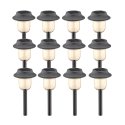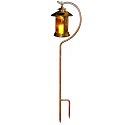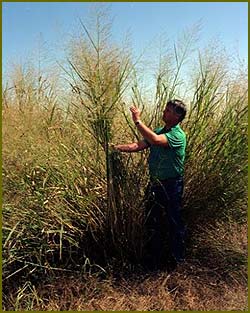|
"Natural building" is an umbrella term than connotes any sort of building that is accomplished with the use of natural materials primarily, as opposed to the use of man-made or industrial materials. There is, of course, a blurring of this distinction when any specific material or building technique is examined, because the influence of technology is all-pervasive in today’s world. Still, it is worthwhile to focus on those ways of building that minimize the use of products that require considerable embodied energy for their manufacture or transportation. The objective is to build with simple techniques that don’t further pollute the environment, consume more fossil fuel, or unnecessarily extract the resources of Mother Earth. Such techniques, by their very nature, have an aesthetic value that tends to blend in with the environment and "feel" natural. |
||||
| Strawbales | ||||
|
Strawbale buildings are all the rage in alternative construction today, and with good reason–they are cheap, easy to build, and very energy efficient. Strawbale buildings look similar to adobe, with massive walls, wide window sills and typically rounded corners, but with the added benefit of a higher insulation value. The soft, sometimes curvy edges of strawbale construction can lend a fairy tale look to the finished structures. The fun part of strawbale construction is that anyone can do it. Anyone can help stack the fluffy, oversized bricks in place. Strawbale homes and outbuildings were first developed by pioneers in the Sand Hills of Nebraska where there was lots of straw, but few trees. The early pioneers built houses of sod, up until the late 1800’s when baling technology provided the first compressed, string-tied rectangular bales. The next logical step was to stack those bales like bricks to make warm walls. Strawbale buildings from the early 1900’s are still in use and in excellent condition today. |
||||
|
Read more of this Article |
||||
|
More Strawbales Links |
||||
| Hotlinks to Additional Internet Resources: | ||||
|
||||
Uncategorized
What is Permaculture?
| Permaculture (permanent agriculture) is the conscious design and maintenance of agriculturally productive ecosystems which have the diversity, stability, and resilience of natural ecosystems. It is the harmonious integration of landscape and people providing their food, energy, shelter, and other material and non-material needs in a sustainable way. Without permanent agriculture there is no possibility of a stable social order.
Permaculture design is a system of assembling conceptual, material, and strategic components in a pattern which functions to benefit life in all its forms. The philosophy behind permaculture is one of working with, rather than against, nature; of protracted and thoughtful observation rather than protracted and thoughtless action; of looking at systems in all their functions, rather than asking only one yield of them; and allowing systems to demonstrate their own evolutions. |
||||
|
Read more of the Article |
||||
| Hotlinks to Additional Internet Resources: | ||||
|
||||
Discover Solar Energy Store
What is Switchgrass?
|
Switchgrass (Panicum virgatum) is a summer perennial grass that is native to North America. It is a natural component of the tall-grass prairie which covered most of the Great Plains, as well as the south and eastern United States.
It is resistant to many pests and plant diseases, and it is capable of producing high yields with very low applications of fertilizer. This means that the need for agricultural chemicals to grow switchgrass is low to non-existent. Switchgrass also is very tolerant of poor soils, flooding and drought. |
|
BioDiesel Videos
| biodiesel basics From: projectbiodiesel Biodiesel can reduce global warming, acid rain and oil wars, but unsustainable production practices are already causing environmental destruction. |
|
| "Willie Nelson on Biodiesel" From: PBS Country music legend Willie Nelson talks about what attracted him to biodiesel, his commitment to American farms and small towns, and why he For more information: |
|
| BioDiesel Man, Part 1 of 2 From: pspmannen how to make biodiesel For more information: |
|
| BioDiesel Man, Part 2 of 2 From: pspmannen how to make biodiesel For more information: |
|
| Dennis Langley on E3 Biofuels From: KelleyCampaigns CEO of E3 Biofuels discusses company’s pioneering closed-loop system for ethanol production with virtually no fossil fuels. |
BioDiesel Videos
| Bio Diesel From: venkatkanna
|
|
| Biodiesel 3/27 Methanol Test From: graydonblair The 3/27 Methanol test is an easy test to see how well reacted Biodiesel is using nothing more than biodiesel and methanol. |
|
| Making BioDiesel at Home From: quizbo707 A walkthrough of the steps for making biodiesel at home, and driving your car for 65-75 cents/gallon |
BioFuel Videos
| Biofuels & Ethanol: The Real Story From: adventureracerx Scientist David Fridley explains the inherent cost and production problems with ethanol and similar biofuels. |
|
| Methanol train From: dutchtrainmanserie22 tanker train run to Rotterdam ,Netherlands. Location Blerick,Netherlands |
|
| Dennis Langley on E3 Biofuels From: KelleyCampaigns CEO of E3 Biofuels discusses company’s pioneering closed-loop system for ethanol production with virtually no fossil fuels. (more) |
|
| Bio-Ethanol Fuel From Woody Biomas : DigInfo From: Diginfonews Japan is a forested country with about 70% of its land comprised of bountiful woodland. The Forestry and Forest Products Research Institute is the only research organization in Japan that comprehensively researches forests in order to know, protect, and utilize this asset. The institute is currently developing a bio-ethanol production technology based on simultaneous glycosylation fermentation using alkali pretreatments and cellulose-producing microorganisms. As a raw material for bio-ethanol, woody biomass doesn’t compete with current food-based ones…. |
BioMass Videos
| Gasifier on the news Switch Grass From: brunnzo Research at Oklahoma State University |
|
| Making Ethanol Work From: Medialink November 2006 (Medialink) — With the recent run up in gas prices and the lingering war in the Middle East, there has been talk of renewable energy sources to power our cars and J11544trucks. Ethanol, a biofuel, can be produced not only from corn, but sugar cane, switch grass, and wood. And using it, instead of gasoline, decreases the amount of pollutants a car emits. But the question remains, "Are there any cars that can run on it?" Brazil started an ethanol program. Recently, Brazil introduced flex fuel vehicles. These vehicles can run both with ethanol, gasoline, ethanol and gasoline in any blend. So these vehicles can be used anywhere. Sweden is also dedicated to reducing its dependence on oil. … |
|
Ethanol Videos
| Biofuels & Ethanol: The Real Story From: adventureracerx Scientist David Fridley explains the inherent cost and production problems with ethanol and similar biofuels. |
|
| Dennis Langley on E3 Biofuels From: KelleyCampaigns CEO of E3 Biofuels discusses company’s pioneering closed-loop system for ethanol production with virtually no fossil fuels. |
|
| Bio-Ethanol Fuel From Woody Biomas : DigInfo From: Diginfonews Japan is a forested country with about 70% of its land comprised of bountiful woodland. The Forestry and Forest Products Research Institute is the only research organization in Japan that comprehensively researches forests in order to know, protect, and utilize this asset. The institute is currently developing a bio-ethanol production technology based on simultaneous glycosylation fermentation using alkali pretreatments and cellulose-producing microorganisms. As a raw material for bio-ethanol, woody biomass doesn’t compete with current food-based ones…. |







